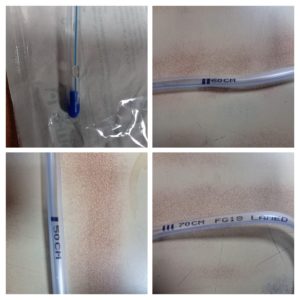Ryle’s Tube is the narrow tube with marked with Radio opaque line. The nasogastric tube used to administer the drugs and feeding Nutritious foods, juices. Ryle’s Tube is also called an (ngt) Nasogastric tube. The length of the orogastric tube about the one-meter length
The radioopaque line helps in the correct insertion of a tube into the stomach
Size available from 6 to 18F in Adult and 10 to 14F in Pediatrics/Infants
Made of medical polyvinyl chloride material and polyurethane
Tip with atraumatic curve allows inserting smoothly, the connector at the end allows connecting to drain or feeding Bag.
Uses of Nasogastric tube
Ryle’s tube used for nutritional feeding purposes or aspiration of gastric secretions.

The tube indicated to aspirate the intestinal obstruction and the pyloric stenosis.
Used in the diagnosis of Gastrointestinal Hemorrhage and acute gastric dilatation.
Enteral feeding in the sick patient and administration of drugs
Used in the examination of Upper gastrointestinal condition
Ryle’s Tube – Materials
Manufactured from non-toxic, medical grade PVC compound.
The distal end coned with steel balls sealed into the tube to facilitates easy insertion.
Four lateral eyes for efficient drainage.
The tube marked at 50, 60 and 70cm from the distal end for accurate placement into the abdomen. The radio-opaque line provided throughout the tube for X-ray visualization. The proximal end is provided with Universal Funnel Connector for easy extension.
How to Insert the nasogastric tube
POsition the patient not to compress the esophagus, lateral position or flex the neck in the supine position with pressure on arytenoid cartilage.
Keep ready with Different sizes of Ryle’s tube, 2 % Xylocaine Jelly, sterile gloves.
The nasogastric tube should be nicely lubricated and passed through one of the nostrils, once it reaches the throat, ask the patient to swallow. so it easily enters into the esophagus and stomach. To check the Ryle’s tube patency push the 5-10ml of fresh air using 10ml or 20 ml syringe. Auscultate with the stethoscope on the epigastric area below the xiphisternum.
If difficult to insert use laryngoscope with Magill’s forceps for insertion and check the tube with X-ray for confirmation
Fixation of the orogastric tube with Elasto plaster or custom made plaster. Fix in a proper way to avoid fracture of nasal cartilage.
Confirmation
Check with the X-Ray for the confirmation of nasogastric tube in the stomach. The Radiographic mark line will appear on the x-ray
Proper Check with Capnography/Entitled carbon dioxide or respiration pattern.
In many cases after insertion, secretion purge outs automatically but this will help you
The wrong placement of the orogastric tube into the trachea will be problematic in patients.
For continuous bedridden patients change the tube once in 7 days.
Note: For intubated patients, If needed Keep ready with Laryngoscopy and Magill forceps.
Sterile, Individually packed in peelable pouch pack. Ryles tube sterilized by is done by Ethylene oxide Sterilization method.
Sizes available
6 FG, 8 FG, 10 FG, 12 FG, 14 FG, 16 FG, 18 FG, 20 FG size NGT tubes
Notes: For better the insertion of the nasogastric tubes keep the tube in the fridge or deep freezer to soften the tube prior to insertion. The low temperature helps in to soften the tube.
Do not reuse the materials once opened or used
The complication of NGT tubes
Discomfort to the patient because of tubes
Nasal bleed/Epistaxis
Mucosal damage of nasal
Esophageal and Gastric reflux
Kinking of tubes and wrong placement in oral or in the trachea